Research

Uniting for SCIENCE to understand the nature of nature
 I am a planetary scientist. But before going into the topic of planetary science including earth science, I want to mention what "Science" is in my view. Science is to explore the causality of natural phenomena. Science is an approach that explores the relation between cause and effect through trial and error for a combination of various elementary processes and conditions, regarding the question "what are the conditions required for the phenomenon to occur?" Science may also be an instinctive activity, coming from human intelligence which quests to understand nature. Simply speaking, I think that science is a process to assign a reason for the various mechanisms of this world.
I am a planetary scientist. But before going into the topic of planetary science including earth science, I want to mention what "Science" is in my view. Science is to explore the causality of natural phenomena. Science is an approach that explores the relation between cause and effect through trial and error for a combination of various elementary processes and conditions, regarding the question "what are the conditions required for the phenomenon to occur?" Science may also be an instinctive activity, coming from human intelligence which quests to understand nature. Simply speaking, I think that science is a process to assign a reason for the various mechanisms of this world.On the contrary, in Japan, we often see the word "science" paired with "technology", as in "kagaku-gijitsu" ("science technology"). From thousands of years ago, Western culture which has found significant value in questioning the mechanism of nature itself, has put the greatest emphasis on science itself rather than science technology. However, the biggest purpose of science that has come to be recognized in Japan is to become the direct benefit to people's lives and to create "technology" (to bring efficiency and good profit). As a result, in Japan, the mindset that does not first and foremost value "science as a tool to explore the causality and mechanisms of the natural phenomenon" has been spread, and eventually only "science technology" came to be primarily valued. This inevitability is understandable in the historical context. After the Second World War, Japan has rapidly reconstructed and achieved huge economic growth mainly through drastic industrialization and urbanization. However, I have been drawn to science to engaged in "science", and I want to continue in this path in the future, rather than the tendency for "science and technology". In addition and through my own work, I hope to promote the value, fun and appeal of pure science to Japan and the world.
 One of the most important and fundamental questions of science is the "origin/s of life". Again, I am a planetary scientist and, in particular, working on the icy moons orbiting giant planets, e.g., Europa and Ganymede in the Jovian system, and Enceladus in the Saturnian system. Through several previous exploration missions, in several icy moons it has been considered that a vast liquid ocean exists beneath the icy crust. The subsurface ocean does not consist only of pure water but some minerals and organics which could be important compounds as building blocks of life are dissolved. Finally scientists are considering that the icy moon and its subsurface ocean may have a potential for harboring extraterrestrial (ET) life. The important point is not to search for ET life but to explore and find an evolutionary path from simple organics to life in the ET environment.
Recently, for example, glycine, the simplest amino acid, was confirmed to be present on comet 81P/Wild 2 from samples returned by NASA's Stardust spacecraft. We now know that biological components are present in the Universe and this first detection of extraterrestrial glycine suggests that amino acids can be formed by abiotic processes in the Universe.
However, further chemical environmental information and subsequent evolution toward functional biopolymers remain unclear. In order to push forward investigation of ET habitability, we need further chemical and environmental information and need to get together various experts from across the world. And eventually I believe we will be able to shed light on the essence of astrobiology.
One of the most important and fundamental questions of science is the "origin/s of life". Again, I am a planetary scientist and, in particular, working on the icy moons orbiting giant planets, e.g., Europa and Ganymede in the Jovian system, and Enceladus in the Saturnian system. Through several previous exploration missions, in several icy moons it has been considered that a vast liquid ocean exists beneath the icy crust. The subsurface ocean does not consist only of pure water but some minerals and organics which could be important compounds as building blocks of life are dissolved. Finally scientists are considering that the icy moon and its subsurface ocean may have a potential for harboring extraterrestrial (ET) life. The important point is not to search for ET life but to explore and find an evolutionary path from simple organics to life in the ET environment.
Recently, for example, glycine, the simplest amino acid, was confirmed to be present on comet 81P/Wild 2 from samples returned by NASA's Stardust spacecraft. We now know that biological components are present in the Universe and this first detection of extraterrestrial glycine suggests that amino acids can be formed by abiotic processes in the Universe.
However, further chemical environmental information and subsequent evolution toward functional biopolymers remain unclear. In order to push forward investigation of ET habitability, we need further chemical and environmental information and need to get together various experts from across the world. And eventually I believe we will be able to shed light on the essence of astrobiology.
To tackle seriously one of the biggest questions in nature, we have to unite beyond the boundaries of the various research fields and each expertise to maximize research progress and benefit by intensively concentrating resources on it. Eventually, I believe that exploring both the origins and evolution of the Earth and other planets/moons and the origins and evolution of life/lives will lead to creating a new field, "Bioplanetology". And personally, I hope and will continue to work so that "science" for understanding natural phenomena will take firmer root on Japanese soil and in the world.
Evolutional Planetology
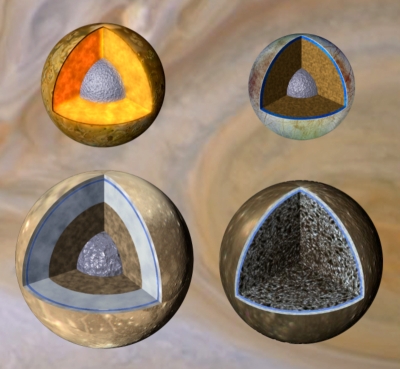 The Solar System contains a diverse range of celestial bodies, including planets such as Earth and Jupiter, natural satellites like the Moon, and small objects such as asteroid Ryugu.
These bodies exhibit considerable variation in characteristics such as size, atmospheric presence, surface morphology, internal structure, and composition.
My research seeks to understand how such diversity arose by investigating the different physical and chemical processes that have driven their evolution.
I primarily use theoretical modeling and telescopic observations to explore these questions.
The Solar System contains a diverse range of celestial bodies, including planets such as Earth and Jupiter, natural satellites like the Moon, and small objects such as asteroid Ryugu.
These bodies exhibit considerable variation in characteristics such as size, atmospheric presence, surface morphology, internal structure, and composition.
My research seeks to understand how such diversity arose by investigating the different physical and chemical processes that have driven their evolution.
I primarily use theoretical modeling and telescopic observations to explore these questions.A fundamental aspect of planetary evolution is the change in internal thermal states over time. The simplest conceptual model involves the gradual cooling of a once-hot planetary interior—a process referred to as thermal evolution or thermal history. In reality, however, this evolution is governed by a complex interplay of heat transport mechanisms such as conduction and convection, internal heating, and material phase transitions. These processes collectively shape the present-day structure and surface of planetary bodies.
Through such thermal evolution, internal stratification can develop, and surface features may arise from material redistribution or volumetric deformation. Volatile components may escape from the interior to form an atmosphere, and fluid metallic cores may give rise to magnetic fields. Conversely, some bodies may have experienced little or no internal evolution. I value a flexible, curiosity-driven approach to selecting research targets, and I am particularly interested in the evolutionary pathways of icy or water-bearing bodies.
Icy Worlds: Extra-terrestrial oceans, extra-terrestrial habitats, and extra-terrestrial life
Most of the natural satellites orbiting the giant planets Jupiter and Saturn have surfaces covered by ice. Similarly, distant Kuiper Belt objects such as Pluto and Eris are also characterized by extensive icy exteriors. I refer to these collectively as "ice bodies". The surfaces of ice bodies often exhibit signs of tectonic activity, including features both familiar from Earth and others that are highly unusual and difficult to interpret. I am particularly intrigued by the diversity and complexity of these surface morphologies.Notable examples include Europa, a Jovian moon marked by numerous fractures and a striking paucity of impact craters; Ganymede, the largest moon in the Solar System, with its vast network of rift-like structures; Enceladus, a Saturnian moon whose geologically young surface and erupting plumes indicate active interior processes; and Titan, which is enveloped in a thick atmosphere and displays surface features reminiscent of fluvial systems. In the outermost regions of the Solar System, NASA's New Horizons mission conducted a flyby of Pluto and revealed that, despite surface temperatures below –200 degC, there are geologically young terrains and clear evidence of large-scale tectonic deformation.
I focus on how this morphological and geological diversity is fundamentally shaped by the presence of "ice". Here, "ice" encompasses not only solid H2O but also a variety of volatile ices such as carbon monoxide, carbon dioxide, nitrogen, methane, and ethane. These substances differ significantly from rock —Earth's and the Moon's primary constituent— in their thermal and mechanical properties, giving rise to unique and often complex geological phenomena.
To understand the tectonic features driven by ice, the internal processes that power them, and their long-term thermal histories, it is essential to clarify the role of ice as a dominant component of these bodies. Disentangling Earth-like features from those unique to ice bodies is a critical step in reconstructing their evolutionary pathways. Such comparative analysis lies at the core of planetary science. The rich variety observed among ice-dominated worlds makes them excellent targets for investigating the origins and implications of diversity across Solar System bodies.
Specific research subjects
Stability of the subsurface ocean in the icy bodies
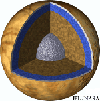 For several icy bodies, a liquid ocean beneath the icy crust has been inferred based on a various observational signatures, e.g., electro-magnetic response and/or tidal response. But we don't know a long-term stability and evolution of the subsurface ocean. We perform numerical simulation for interior thermal evolution and changing of interior structure with time. Also, thickness changing of the subsurface ocean could induce a stress in the solid ice crust to form the tectonic ativities (see below) [imaged by NASA].
For several icy bodies, a liquid ocean beneath the icy crust has been inferred based on a various observational signatures, e.g., electro-magnetic response and/or tidal response. But we don't know a long-term stability and evolution of the subsurface ocean. We perform numerical simulation for interior thermal evolution and changing of interior structure with time. Also, thickness changing of the subsurface ocean could induce a stress in the solid ice crust to form the tectonic ativities (see below) [imaged by NASA].
Surface geology and icy tectonics of icy bodies
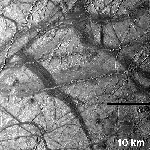 Most of solid bodies in the outer solar system have a surface mostly composed of ice, and on their surface various types of the tectonic features can be seen. We investigate the stress sources for the formation of these features, i.e., growing of the icy crust (solidifying the subsurface ocean), expanding the surface and tensile stress could be generated. It could be a primary source of the tectonis of the icy bodies having the ocean. The point is, such processes must be essentially related to the internal thermal history [imaged by NASA].
Most of solid bodies in the outer solar system have a surface mostly composed of ice, and on their surface various types of the tectonic features can be seen. We investigate the stress sources for the formation of these features, i.e., growing of the icy crust (solidifying the subsurface ocean), expanding the surface and tensile stress could be generated. It could be a primary source of the tectonis of the icy bodies having the ocean. The point is, such processes must be essentially related to the internal thermal history [imaged by NASA].
Dynamo activity in the planetary core
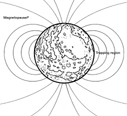 Galileo spacecraft has discovered the strong intrinsic magnetic field on Ganymede. This field is considered to mainly originate by self-excited dynamo activity in the metallic core. The driving of dynamo depends critically on the thermal state and internal structure. However, inferred structure based on gravity data has large uncertainty and this makes the possibility of dynamo activity unclear; variation of the core size and the composition greatly change the heat capacity and hence, it alters the cooling history of the core. We perform the numerical simulation on the thermal history of the core and try to constrain the size and composition of the metallic core based on the condition of driving a dynamo activity [imaged by NASA].
Galileo spacecraft has discovered the strong intrinsic magnetic field on Ganymede. This field is considered to mainly originate by self-excited dynamo activity in the metallic core. The driving of dynamo depends critically on the thermal state and internal structure. However, inferred structure based on gravity data has large uncertainty and this makes the possibility of dynamo activity unclear; variation of the core size and the composition greatly change the heat capacity and hence, it alters the cooling history of the core. We perform the numerical simulation on the thermal history of the core and try to constrain the size and composition of the metallic core based on the condition of driving a dynamo activity [imaged by NASA].
Astrobiology
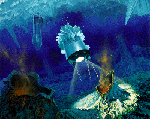 Ice covered satellites and planets are common in the solar system. Many of large icy satellites indicating the existence of a liquid water layer are strong candidate for extraterrestrial life. Jovian satellite Europa is one of the most significant example which has implied by magnetic observations and geomorphological interpretations. We focus on the hydrothermal activity in the region between internal liquid ocean and solid rocky mantle and evaluate the thermal and chemical affects.
Ice covered satellites and planets are common in the solar system. Many of large icy satellites indicating the existence of a liquid water layer are strong candidate for extraterrestrial life. Jovian satellite Europa is one of the most significant example which has implied by magnetic observations and geomorphological interpretations. We focus on the hydrothermal activity in the region between internal liquid ocean and solid rocky mantle and evaluate the thermal and chemical affects.Also, we investigate chemical evolution in the icy moon's environment. In particular, we perform thermodynamic calculations (e.g., free energy) for polymerization of amino acids and other building bloks of life.